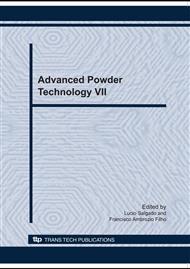p.3
p.11
p.17
p.23
p.29
p.35
p.41
p.46
Interstitial Control in Titanium Alloys Produced by Powder Metallurgy
Abstract:
The titanium alloys are used for applications that demand high performance, including surgical implants and aerospace applications. Powder metallurgy is an advantageous alternative for titanium parts production with complex geometries at a relative low cost. Despite that, it is verified that the introduction of interstitial elements (oxygen, nitrogen and carbon) wile processing these alloys, though can increase hardness and mechanical resistance, which is frequently related to the reduction of ductility and fragility increase. The objective of this work is to investigate the influence of the interstitial elements in commercially pure Ti and Ti-13Nb-13Zr alloy produced by powder metallurgy (P/M). Samples were produced by the mixing of hydrided metallic powders followed by uniaxial and cold isostatic pressing with subsequent densification by sintering at 1400 °C, in vacuum. Sintered samples were characterized for phase composition, microstructure and microhardness by X-ray diffraction, scanning electron microscopy and Vickers indentation, respectively. The interstitial content was analyzed by Leco equipment. It was shown that the samples were sintered to high densities with a Widmanstatten microstructure. The oxygen and nitrogen contents are above the ELI (Extra Low Interstitial) and the critical issues were identified in the original blended elemental route.
Info:
Periodical:
Pages:
3-10
Citation:
Online since:
October 2010
Price:
Сopyright:
© 2010 Trans Tech Publications Ltd. All Rights Reserved
Share:
Citation:


